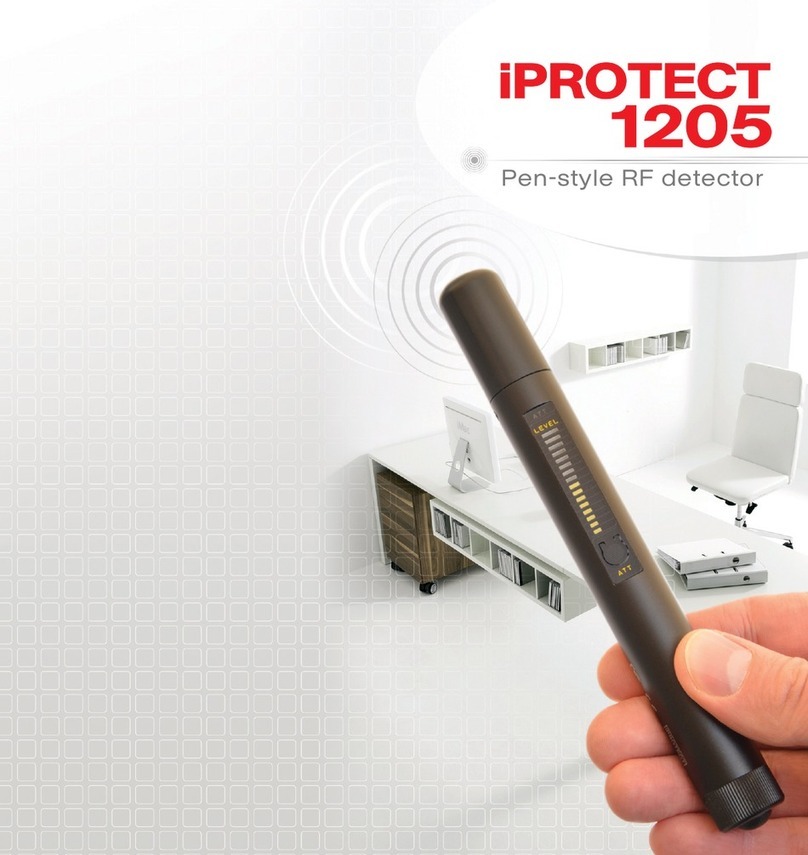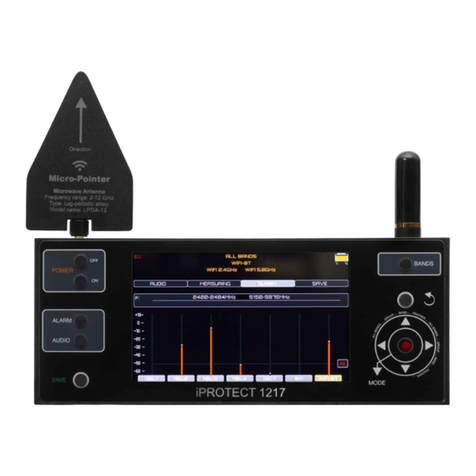6 7
The iProtect 1215 pointer is an auxiliary device
designed to extend the checked frequency range
during the TSCM sweeping procedure. Therefore
it should be used together with a standard RF de-
tector or other equipment in order to perform a
comprehensive check.
SWEEPING
DETECTING DISTANCE
To avoid false detections turn off all RF trans-
mitting devices before starting the sweeping
procedure:
Wi-Fi routers and Wi-Fi devices
(printers, video cameras, laptops, etc.)
Cordless phones
Cell phones
Bluetooth devices, etc.
Start with the attenuator turned off. Enter the
room while holding the pointer and start probing
objects and surfaces with its antenna (upper tip).
Since some types of transmitters have extremely
low power, it is recommended to carry out the
inspection at a distance of not less than 10-20 cm
from the object.
Since the pointer's antenna is directed, rotate the
device in different directions during the scan to
maximize the chances of catching a signal.
Move around the room in a selected direction –
clockwise or counter clockwise and probe all the
items/surfaces/gaps, etc. Pay special attention to
the places where electrical wires are present as a
potential bugging device could be powered by
these. Do not forget about any objects situated
in the middle of the room. Open all wardrobes,
cabinets, etc. since a bugging device could be
anywhere; test the ceiling (opening tiles of neces-
sary) and the floor. Use a ladder if necessary to get
as close to high points in the room as possible.
most important since sound around this area is
clearest; therefore inspect it with as much care as
possible.
An increased RF level on the bargraph and/or
vibration from the 1215 are signs of microwave
signals, which can be produced both by a normal
device like a Wi-Fi router or a real bugging device,
for example by 5 GHz video or audio bugging
device. To avoid false alarms during the sweeping
procedure turn off the 'legal and known' Wi-Fi
routers temporarily. Activate the flight mode on all
mobile phones present in the checked premises.
The task of operator is to find the place with the
maximum RF level and then to trace the transmit-
ter. If it is impossible to find the strongest place
and the signal is similar everywhere (for example
near a window), it may be external interference.
In modern cities there is lot of interference like
communication base stations or broadcasting.
Please remember that interference may also get
into a room from adjacent premises. It can be
a Wi-Fi router in the neighboring flat/office, for
example.
If the RF level is strong, the bargraph may show
the maximum level. The attenuator function will
be useful in this case. Turn it on and continue
searching for the place with the maximum level,
after finishing and returning to the normal sweep
do not forget to turn off the attenuator.
Do not stop sweeping even if a bugging device is
found. Some other, better hidden, bugging devi-
ces may be still present in the room.
Depending on the transmitter's power and
frequency the distance may vary from 20 cm to
2-3 meters
After finding a place with a strong RF level go to
a physical inspection. Disassemble the object and
try to find the transmitter
The target zone (the area around the most used
work space in the room being checked) is the























